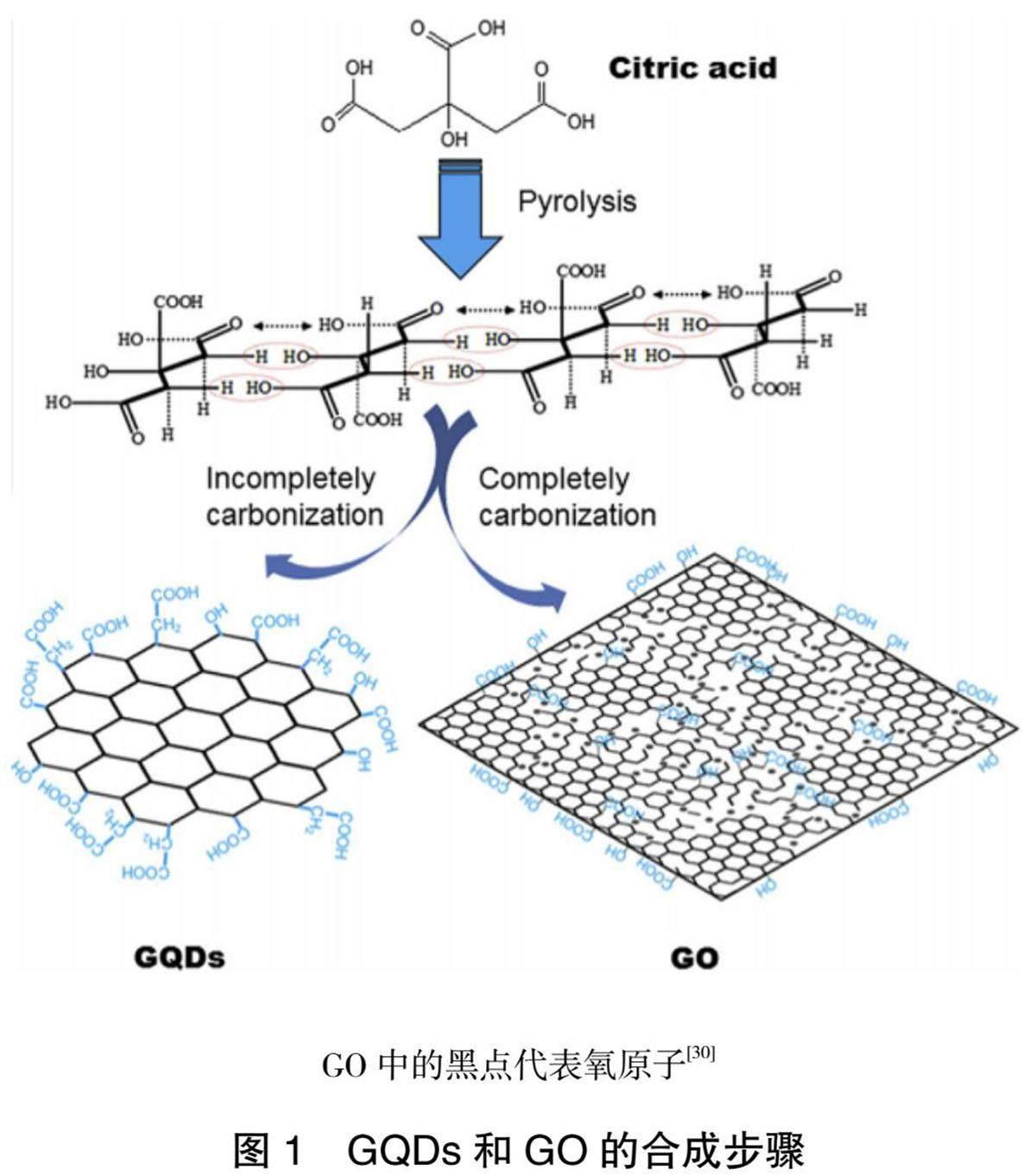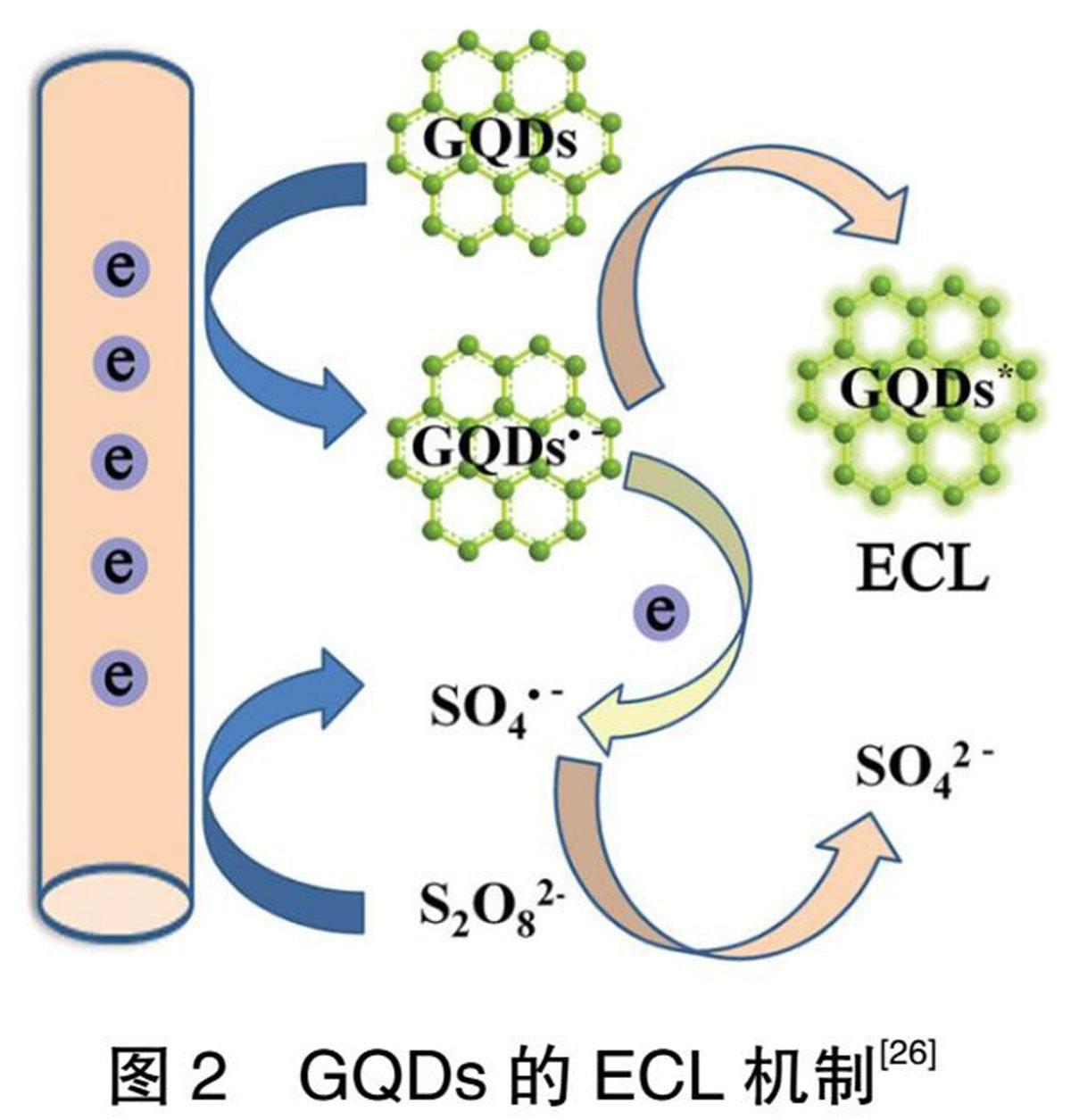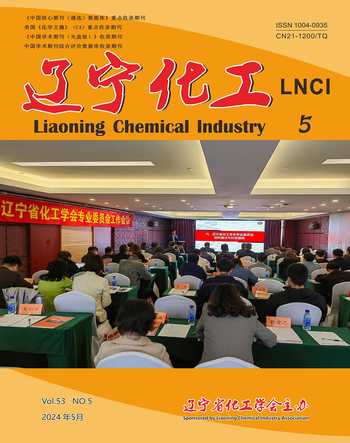石墨烯量子点的制备及光学性质的研究
陈树帆 赵会燕 王璐 赵树人


摘 要:碳纳米材料由于独特的电学光学性质得到了广泛的关注。其中石墨烯量子点由于好的光学稳定性、丰富的表面修饰、低毒、高的生物相容性等特点被大量学者广泛合成研究。首先介绍了石墨烯量子点的基本合成方法,在此基础上,对石墨烯量子点光学性质的研究现状进行了概述。
关 键 词:石墨烯量子点;制备;光学性质
中图分类号:TQ323 文献标识码: A 文章编号: 1004-0935(2024)05-0761-04
近年来,由于富勒烯、碳纳米管(CNTs)和石墨烯的发现,以碳为基础的纳米材料(CNMs)凭借其独特的光学,电学,热力学性质和机械性能受到了众多科研工作者的关注与研究[1-6]。碳量子点(CQDs),通常也叫作碳点(CDs),是指直径小于10 nm的荧光碳纳米粒子(CNPs),CQDs具有化学稳定性高、导电能力好、宽的光吸收带等优点[7-10]。石墨烯量子点(GQDs),是CQDs的一个子集,是指直径尺寸小于100 nm的石墨烯纳米片层,通常来源于石墨烯或氧化石墨烯[11-12]。作为一种新型量子点,由于显著的量子限域和边际效应,GQDs表现出许多新颖的物理化学性质。GQDs还具有低细胞毒性、良好的溶解性、化学惰性、稳定的光致发光、良好的表面接枝等优点[13-15]。由于这些独特的性质,很多学者研究了很多方法合成了GQDs,并对合成的GQDs的物理化学性质进行了研究。
1 石墨烯量子点的制备
目前,GQDs的制备方法已经得到了大量的研究,主要分为两大类:自上而下(top-down)法和自下而上(bottom-up)法[16-19]。Top-down方法主要包含水热法、电化学法、微波辅助法等,主要是将大尺寸的碳质材料分裂切割从而得到小尺寸的GQDs。Bottom-up方法包含溶液化学法、有机分子前体法等,主要是利用一些小分子作为前体,经过一系列化学反应得到GQDs。
1.1 自上而下(top-down)途径
水热法。Pan等利用水热法以石墨烯片层(graphene sheets, GSs)为原材料成功合成了GQDs[20-21]。得到的GQDs平均尺寸9.6 nm,发强烈的蓝光。实验首先对氧化石墨烯(graphene oxide, GO)进行热还原得到GSs,接着用浓H2SO4和浓HNO3在200 ℃对GSs进行氧化,氧化后GSs尺寸发生显著变化(50 nm~2μm),最后通过透析分离得到超细GQDs,尺寸范围(5~13)nm(平均直径9.6 nm)。Zhu等、Shen等利用水热法以GO为原材料合成了GQDs[22-23]。
电化学法。Li等利用电化学法成功合成了GQDs[24],尺寸(3~5)nm,发强烈绿光,其水溶液能够稳定保存数月。制备方法:在0.1 M(mol/L)的磷酸缓冲溶液中(PBS),以石墨烯薄膜(5 mm×10 mm)作为工作电极,Pt丝和Ag/AgCl分别做为对电极和参考电极,进行循环伏安扫描,扫描电压±3.0 V,扫描频率0.5 V/s。利用纤维素酯膜袋分离透析得到水溶性的GQDs溶液。Zhang等利用电化学法成功合成了GQDs[25],合成的GQDs量子产率高达14%,平均尺寸5~10 nm,发强烈的黄光。
微波辅助法。微波辅助法结合了水热法和微波法的共同优点,加热方便快捷,在GQDs的制备中能够显著减少反应时间、提高产物量子产率。Li等利用微波辅助法在酸性条件下以GO为原材料制备了两种颜色的GQDs[26]。
1.2 自下而上(bottom-up)途径
溶液化学法。基于氧化缩合反应,Li课题组利用溶液化学法合成了GQDs[27,28],实验以3-碘-4-溴苯胺和溴苯甲酸为原料,得到的GQDs尺寸均匀可控,分别包含了168、132、170个共轭碳原子。
有机分子前体法。在一些特定条件下,通过热解或碳化,一些有机小分子可以作为原材料来制备GQDs。Tang等利用葡萄糖作为原材料且没有其他试剂的条件下合成了GQDs[29]。并且该实验发现通过增加加热时间,产物的尺寸也会增大。实验中,加热时间从1 min延长到9 min,GQDs尺寸从1.65 nm增大到21 nm。Dong等通过柠檬酸的碳化制备出了GQDs和GO,过程如图1所示[30]。
GO中的黑点代表氧原子[30]
Top-down 和bottom-up这两种方法各有利弊,top-down合成方法具有原材料丰富,合成量大,操作简单等优点,而且得到的GQDs边缘通常含有氧化功能基团,能够促进GQDs的溶解、功能化和钝化。其缺点是需要特定的设备、量子产率低、选择性差,产物尺寸形态无法控制。与top-down方法不同,bottom-up可以有效控制产物的尺寸、形状和性质。但是也存在一些问题,比如说合成的GQDs容易聚集,产物尺寸较小(大多在5 nm以下),合适的前体分子不容易找到。
2 石墨烯量子点的光学性质
2.1 紫外-可见吸收(UV-vis)
在GO的UV-vis光谱中,可以观察到230 nm处有一个特征峰,这个特征峰是芳香C=C键的π-π*跃迁所形成。在GQDs中, 320 nm处出现了新的谱带, 这是由于C=O键的n-π*跃迁所引起
的[20,24,31]。Peng等分别在80 ℃、100 ℃、120 ℃下合成了GQDs,随着温度的增加,GQDs的UV-vis吸收峰出现了明显的蓝移,从330 nm移动到
270 nm[32]。Tang等利用水热法制备得到的GQDs在228 nm、282 nm处有两个特征峰,且随着加热时间的增加,GQDs尺寸的增加,两个特征峰位置不变[29]。可以发现,通过不同条件制备得到的GQDs,UV-vis光谱略有不同。
2.2 光致发光(Photoluminescence)
尺寸依赖。由于量子限域效应,GQDs光致发光(Photoluminescence, PL)表现出尺寸依赖特点。Peng等在不同温度下制备出尺寸不同的GQDs, A溶液GQDs尺寸为1~4 nm,B溶液GQDs尺寸为4~8 nm, C溶液GQDs尺寸为7~11 nm,可以看出尺寸不同,PL不同[32]。
激发依赖。对于碳基荧光材料来说,发射波长和强度随激发波长的变化而变化是一种常见的现象。GQDs也存在这种现象。在Pan等的实验中[20],当激发光波长从320 nm增加到420 nm,GQDs的最大发射波长逐渐增加,发射强度迅速降低。发射强度在320 nm处最高。Li等利用电化学方法合成的GQDs中也出现了此种现象[24]。当激发波长在吸收峰(UV-vis)320 nm附近时,PL发射波长在473 nm,强度达到最大。这种性质可能是由于不同尺寸GQDs的光选择性和不同发射位点[13,23]。
2.3 电致化学发光(Electrochemiluminescence, ECL)
ECL具有选择性高、检测范围宽、灵敏度高等优点。许多量子点(Si、CdSe、CdTe、CDs)等都被发现能够产生ECL[33-35]。2012年,Li等首次发现GQDs的ECL[26]。实验以K2S2O8作为共反应物,循环电压为0 V~(-1.6)V,GQDs在-1.45 V时出现强烈的ECL信号。发光机制如图2所示。
3 结 论
本文对GQDs的合成方法、光学性质的当前研究进展进行了介绍。可以发现,大量学者对GQDs的合成方法进行了研究,所用原材料、处理过程、所用设备不同,制备出了各种尺寸、形态的GQDs。文章也对GQDs的紫外-可见、光致发光、电致化学发光性质做了介绍。
这些独特的电学、光学性质也使得GQDs在化学分析、光学材料、医学、生物学领域都得到了广泛的应用[36-39]。未来,相信随着广大学者的研究,更多快速简单、高质量GQDs(例如良好的尺寸控制、形状控制、良好的水溶性)的合成方法被进一步探索出来,更多独特的电学光学性质被研究发现,为GQDs的广泛应用打下更加坚实的基础。
参考文献:
[1]KUMAR S J, NILA N K, RAZ J. Carbon nanomaterials in microbial sensing and bactericidal applications[J]. Current Opinion in Colloid & Interface Science, 2023, 66: 101719.
[2]CHI H, LIU G. Carbon nanomaterial-based molecularly imprinted polymer sensors for detection of hazardous substances in food: Recent progress and future trends[J]. Food Chemistry, 2023, 420: 136100.
[3]PARIHAR A, CHOUDHARY N K. Carbon nanomaterials-based electrochemical aptasensor for point-of-care diagnostics of cancer biomarkers[J]. Materials Today Chemistry, 2023, 30: 101499.
[4]KATHIRVEL B, HAKIM A G. Carbon nanomaterials: Types, synthesis strategies and their application as drug delivery system for cancer therapy[J]. Biochemical Engineering Journal, 2023, 192: 108828.
[5]HUANG D, DAI J, LI Z, et al. Effect of carbon-based nanomaterials on the wave absorption properties of hollow ZnFe2O4[J]. Materials Science and Engineering: B, 2023, 193: 116462.
[6]郭帅,韩兴威,孙杰,等.三维石墨烯及其复合材料的制备与吸附性能研究进展[J].辽宁化工, 2023, 52(07): 1016-1023.
[7]NAMDARI P, NEGAHDARI B, EATEMADI A. Synthesis, properties and biomedical applications of carbon-based quantum dots: an updated review[J]. Biomedicine and Pharmacotherapy, 2017, 87: 209-222.
[8]ANGELIN A, MUHAMMED A, ALEENA E, et al. WO3·0.33H2O/ carbon quantum dots hybrid nanostructures for efficient electrochemical hydrogen evolution reaction[J]. Diamond and Related Materials, 2023, 139: 110309.
[9]HE Y, CHENG K, ZHONG Z, et al. Carbon quantum dot fluorescent probe for labeling and imaging of stellate cell on liver frozen section below freezing point[J]. Analytica Chimica Acta, 2023, 1260: 341210.
[10]KIM B, OH G, SONG Y, et al. Acid catalyzed microwave-assisted production of full-color light emissive carbon quantum dots for CCT-tunable WLEDs[J]. Applied Surface Science, 2023, 640: 158301.
[11]XU Y, LIU J, GAO C, WANG E. Applications of carbon quantum dots in electrochemiluminescence: A mini review[J]. Electrochem. Commun., 2014, 48: 151-154.
[12]MA W, WANG J, WU T, et al. Three-dimensional nitrogen-doped graphene quantum dots/reduced graphene oxide composite hydrogels as binder-free electrodes for symmetric supercapacitors[J]. Materials Chemistry and Physics, 2023, 128365.
[13]LI L, WU G, YANG G, et al. Focusing on luminescent graphene quantum dots: current status and future perspectives[J]. Nanoscale, 2013, 5: 4015-4039.
[14]ELISABETE R, LUANA B, EDUARDO R, et al. Chitosan-graphene quantum dot based active film as smart wound dressing[J]. Journal of Drug Delivery Science and Technology, 2023, 80: 104093.
[15]ABBAS A, RUBAB S, REHMAN A, et al. One-step green synthesis of biomass-derived graphene quantum dots as a highly selective optical sensing probe [J]. Materials Today Chemistry, 2023, 30: 101555.
[16]SHEN J, ZHU Y, YANG X, et al. Graphene quantum dots: emergent nanolights for bioimaging, sensors, catalysis and photovoltaic devices[J]. Chem. Commun., 2012, 48: 3686-3699.
[17]LOPEZ-PICAZO P, SANCHEZ-TIZAPA M, TOSTADO- PLASCENCIA M, et al. Characterization of sensitized solar cells based on nanocomposites of protoporphyrin IX and microwave reduced graphene oxide quantum dots[J]. Diamond and Related Materials, 2023, 139:110337.
[18]SHUVAM S, SOMYAJIT P, ARITRA P, et al. A review on synthesis, toxicity profile and biomedical applications of graphene quantum dots (GQDs) [J]. Inorganica Chimica Acta, 2023, 557: 121677.
[19]SHI L, WANG B, LU S. Efficient bottom-up synthesis of graphene quantum dots at an atomically precise level [J]. Matter, 2023, 6(3): 728-760.
[20]PAN D, ZHANG J, LI Z, et al. Hydrothermal route for cutting graphene sheets into blue‐luminescent graphene quantum dots[J]. Advanced materials, 2010, 22: 734-738.
[21]FACURE M, SCHNEIDER R, MERCANTE L, et al. Rational hydrothermal synthesis of graphene quantum dots with optimized luminescent properties for sensing applications[J]. Materials Today Chemistry, 2022, 23: 100755.
[22]SHEN J, ZHU Y, CHEN C, et al. Facile preparation and upconversion luminescence of graphene quantum dots[J]. Chemical communications, 2011, 47: 2580-2582.
[23]ZHU S, ZHANG J, QIAO C, et al. Strongly green- photoluminescent graphene quantum dots for bioimaging applications[J]. Chem. Commun., 2011, 47: 6858-6860.
[24]LI Y, HU Y, ZHAO Y, et al. An electrochemical avenue to green-luminescent graphene quantum dots as potential electron-acceptors for photovoltaics[J]. Advanced Materials, 2011, 23: 776-780.
[25]ZHANG M, BAI L, SHANG W, et al. Facile synthesis of water-soluble, highly fluorescent graphene quantum dots as a robust biological label for stem cells[J]. Journal of materials chemistry, 2012, 22: 7461-7467.
[26]LI L, JI J, FEI R, WANG C, et al. A facile microwave avenue to electrochemiluminescent two-color graphene quantum dots[J]. Adv. Funct. Mater., 2012, 22: 2971-2979.
[27]YAN X, CUI X, LI L. Synthesis of large, stable colloidal graphene quantum dots with tunable size[J]. Journal of the American Chemical Society,2010, 132: 5944-5945.
[28]YAN X, CUI X, LI B, et al. Large, solution-processable graphene quantum dots as light absorbers for photovoltaics[J]. Nano letters, 2010, 10: 1869-1873.
[29]TANG L, JI R. Deep ultraviolet photoluminescence of water-soluble self-passivated graphene quantum dots[J]. ACS nano, 2012, 6: 5102-5110.
[30]DONG Y, SHAO J, CHEN C, et al. Blue luminescent graphene quantum dots and graphene oxide prepared by tuning the carbonization degree of citric acid[J]. Carbon, 2012, 50: 4738-4743.
[31]ZHENG M, XIE Z, QU D, et al. On-off-on fluorescent carbon dot nanosensor for recognition of chromium (VI) and ascorbic acid based on the inner filter effect[J]. ACS applied materials & interfaces, 2013, 5: 13242-13247.
[32]PENG J, GAO W, GUPTA B K, et al. Graphene quantum dots derived from carbon fibers[J]. Nano letters, 2012, 12: 844-849.
[33]DING Z, QUINN B M. Electrochemistry and electrogenerated chemiluminescence from silicon nanocrystal quantum dots[J]. Science, 2002, 296: 1293-1297.
[34]MYUNG N, DING Z, BARD A. Electrogenerated chemiluminescence of CdSe nanocrystals[J]. Nano Letters, 2002, 2: 1315-1319.
[35]BAE Y, MYUNG N. Electrochemistry and electrogenerated chemiluminescence of CdTe nanoparticles [J]. Nano Letters, 2004, 4: 1153-1161.
[36]HSIEH C, SUNG P, GANDOMI Y, et al. Microwave synthesis of boron- and nitrogen-codoped graphene quantum dots and their detection to pesticides and metal ions[J]. Chemosphere, 2023, 318: 137926.
[37]PRATIK K, AKANKSHA R, SONU G. Fabrication of an ultrasensitive electrochemical immunosensor coupled with biofunctionalized zero-dimensional graphene quantum dots for rapid detection of cephalexin[J]. Food Chemistry, 2023, 398: 133846.
[38]LUO K, LUO X, WU Y, et al. Synthesis of graphene quantum dots with temperature-sensitive properties from sea rice for rapid and highly selective detection of 4-nitrophenol[J]. Diamond and Related, Materials, 2023, 135: 109849.
[39]WAN H, MUNDZIR A, MOHAMAD A, et al. The valorisation of grass waste for the green synthesis of graphene quantum dots for nonlinear optical applications[J]. Optical Materials, 2022, 132: 112853.
Research on Preparation and Optical
Properties of Graphene Quantum Dots
CHEN Shufan, ZHAO Huiyan , WANG Lu, ZHAO Shuren
(Zhengzhou Product Quality Inspection and Testing Center, Zhengzhou Henan 450000, China)
Abstract: Carbon nanomaterials has received intensive attention due to unique electrical and optical properties. Among them, graphene quantum dots has been extensively synthesized and studied by a large number of scholars because of their good excellent stability, rich surface modification, low toxicity and high biocompatibility. In this paper, the basic synthesis method of graphene quantum dots was firstly introduced, and the optical property research status of graphene quantum dots was summarized.
Key words: Graphene quantum dots; Synthesis; Optical properties
收稿日期: 2023-09-04
作者简介: 陈树帆(1991-),女,河南省驻马店人,助理工程师,硕士研究生,2017年毕业于吉林大学分析化学专业,研究方向:产品检验检测。
通信作者: 赵树人(1965-),男,副处级,硕士研究生,研究方向:产品检验检测、计量检定。

